Sustaining Spirit in Hard Times: People are Complicated
Tagged:Beauty
/
COVID
/
Obscurantism
/
Politics
/
Religion
/
Sadness
/
ϜΤΦ
Times are difficult, here in the 3rd year of a global pandemic that drags on and on, because people just cannot grasp the importance of public health measures and vaccination. Anything that sustains our spirit and our belief in a good core of human nature is important. So why am I looking at dog statues on bridges in Prague?
Restoring faith in human nature
The world just now is full of the ignorant and the fascist, for some reason. Anything that can restore at least some of my faith in human nature is welcome.
On the other hand: avoiding things that destroy my faith in human nature is a survival tactic for me, for many years now. That’s why I don’t have social media accounts: no Bookfacery, no Twittage, no Instagrammaton, no TackyTonk, no WhatsOpera… none of that. I have very little patience with performative stupidity (unless done as satire and done well, by somebody like Monty Python).
But there are, occasionally, interesting people who do use social media, and I’d like to know what they think. Other people whom I respect (for reasons other than their social media hygiene) trawl through the social media sewers and post interesting bits they find on their blogs. That I will read, occasionally dipping into a Twitter thread blessed by tasteful people I trust. (But not Facebook: I won’t touch Facebook, not even with the legendary Ten Foot Pole of Touching. Now, I might stab corporate Facebook using a ten foot pikestaff with a venom tip… but lacking the context for medieval anti-cavalry weapons, that is unlikely to matter. Yes, I am a cranky old man. How are you only just realizing this now? Have I not provided you with sufficient evidence for that conclusion already?!)
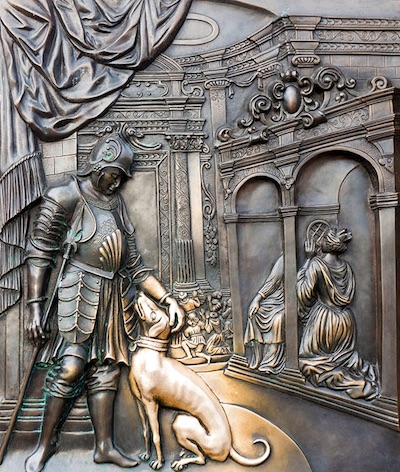 And so it is today: somebody or other pointed me at somebody else or other, who tweeted a photo
showing a more or less late medieval European soldier and his loyal dog. The dog had been
burnished shiny by passers-by who also wanted to pet the dog (click to embiggen, for most
of these images).
And so it is today: somebody or other pointed me at somebody else or other, who tweeted a photo
showing a more or less late medieval European soldier and his loyal dog. The dog had been
burnished shiny by passers-by who also wanted to pet the dog (click to embiggen, for most
of these images).
Isn’t it nice that, even in a pandemic and the revenance of fascism, people want to do a basic kindness, like petting a dog?
Well… yes, but… I have questions.
Digging deeper
I always have questions. Here are just the top few:
- Where is this sculpture, who put it there, and why?
- Why a soldier? This soldier has a scallop on his brassard which indicates service in a pilgrimage and some affiliation with St James the Greater, patron saint of Spain. So which conflict was he in and what should I think about this soldier?
- Who are all those people behind the soldier, kneeling on something like steps, with their hands upraised?
- Who is the woman to the right, talking into a grille of some sort? Why can’t we see anything other than the legs of the person on the other side of the grille?
- What’s with the weird architecture: elaborate curtain on the upper left like a stage setting (memory theatre of the soldier’s memories?), and elaborately sculpted columns in the style of Corinth with spears around the base?
- Why is the soldier holding what almost looks like a Roman pilum, a short spear for close-in fighting? This is not normally an implement of dog-petting (unless I’ve been doing it wrong my whole life, and the dogs have just been really forgiving of my lapse in petting without weapons?).
- If the soldier is ready to fight with the weapon he’s holding, then why is he barefoot?!
So many, many questions.
Okay, start with where
Let’s start with the simplest of factual questions that we can actually answer: where was this photograph taken? I despair of looking at the EXIF properties of the JPG image, since people quite regularly monkey with those. (I’m slightly disappointed nobody has yet tried to convince me their image was taken on Mars. Get on that, will you?)
However, a few minutes of quality time with Google Lens exhumed a boatload of similar (even near-identical) images, complete with explanations of who, what, when, where, and why. It turns out this is a relief sculpture at the base of a statue on the Charles Bridge built in 1357 over the Vltava River in Prague, the capital of the Czech Republic. For 500 years, it was the only way to cross the river with a horse and carriage/cart, so all the streets in Prague sort of funnel traffic toward the bridge. It was originally called “the bridge”, since it was the only one; you only need names when you have 2 or more of something. (Practical folk, the residents of Prague.)
Interesting enough, but more to the point: the 40 statues on the bridge (actually 39 + one cross with 5 stars) are a bit of a tourist attraction, hence the fame of photos like this. One very helpful Prague tourist site, LivingPrague, explained a great many fascinating and occasionally disturbing details. [1] The pictures reproduced here are from LivingPrague, and some clearer versions from My Modern Met [2]. The video here is also kind of interesting: it shows the late medieval construction techniques for building such a bridge: largely with nothing but human and animal muscle power, augmented by clever leverage and wheels.
Legend says construction of this bridge was started personally by Emperor Charles IV, king of Bohemia and later Holy Roman Emperor at 5:31am on 1357-Jul-09, because in the notation of the day (1357 9/7 5:31) the numbers formed a palindrome. Weird cat, that Charles neé Wenceslaus.
That is your fair warning that the going is about to get weird. Deeply weird.
Fine, but why a dog? And what else is there?
Why couldn’t it have been a duck instead of a dog? I had a perfectly good Marx Brothers gag all ready to go. It was just sitting right there, and now it’s going to waste! Sigh.
Ok, no duck. But why a dog? And what else is going on here? As it turns out, rather a lot.
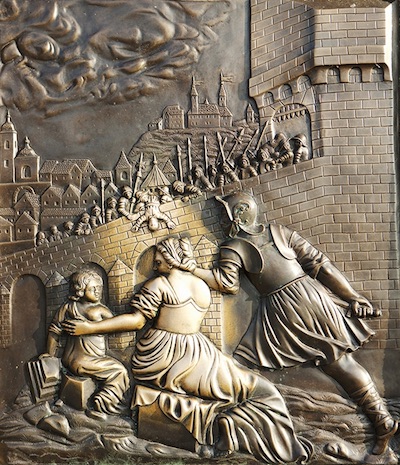 The image of the soldier, his highly polished dog, and the fascinating other stuff is at
the base of a statue (which we’ll look at in a minute). If you move just a meter or two
to the right, you see this relief instead. Something weird, disturbing, dark, and violent
is happening here:
The image of the soldier, his highly polished dog, and the fascinating other stuff is at
the base of a statue (which we’ll look at in a minute). If you move just a meter or two
to the right, you see this relief instead. Something weird, disturbing, dark, and violent
is happening here:
- Storm clouds are gathering in the upper left, perhaps as a sign of divine displeasure.
- A bunch of armored soldiers, armed with spears or pikes and coming out from a portcullis, are on a bridge.
- They appear to be forcibly throwing someone off the bridge, upside-down. It’s unlikely to be a friendly dunking prank at some medieval cosplay fraternity. (Please don’t tell me there actually are medieval cosplay fraternities; I’d really rather not know that.)
- In the foreground, a well-dressed woman with coiffed hair (likely a noble), is watching under what appear to be the dual influences of a cherub to her left and another soldier on her right.
- The soldier has drawn his sword in his right hand, and is reaching out toward her with his left, so this is an image of compulsion.
- The image is burnished by people touching it in 2 places: the woman’s back, and the poor victim being tossed athwart the bridge (so much so that he’s almost worn smooth).
What in the world?! Not so peaceful as a picture of some guy petting his dog any more, is it?
Maybe the dog isn’t the main point being made here.
Jan Nepomuk
Meet Jan Nepomuk (Jan Nepomucký, first name pronounced with a Y sound, something like “Yahn”), c1345 – 1393-Mar-20, patron saint of Bohemia and (somewhat ironically) protector from drowning.
Whenever a death date is given like that with extreme precision, you should expect a gory, detailed story of martyrdom. And so it is here. The image depicts our man Jan surrounded by his trademark 5 stars, in repose at the bottom of the Vlatava River, having drowned. Under – can you guess? – this very bridge.
While there are plenty of details of his life, they are, in keeping with tradition either somewhat lost, or confused with another Jan who lived about the same time, or just the stuff of legend. This is normal, so let’s consider his legend. He came from a village called Pomuk, which later merged with a nearby village and became known as Nepomuk. So that’s not a surname, it just says he’s “that guy Jan, you know, the one from the village of Nepomuk?”
He became a priest, Catholic of course, and apparently advanced to relatively high degree. That meant he was a member of one hierarchy (Gr hieros + arkhein = holy/priestly rulers) competing against another hierarchy, the aristocracy and royals. Funny thing about hierarchies: they do not play well with others. What they do is demand submission to their dominance displays. Accounts vary, but one of a couple things happened:
- Jan Nepomuk somehow got caught in the gears of the machinery of conflict between church and state. King Wenceslas IV wanted to appoint bishops himself, while the Catholic hierarchy had other ideas. So… a conflict of political power?
- Jan Nepomuk was hearing the confession of Queen Sophia, and afterwards the jealous King Wenceslas wanted to know what his wife said. The Seal of the Confessional meant absolute secrecy. So… a conflict with a very powerful, very jealous, very enraged husband?
Situation number 2 is what’s depicted in the reliefs above. The woman in the background of the first relief is speaking into the grille in a confessional. The priest on the other side, who in keeping with anonymity cannot be seen totally, is Jan Nepomuk. What’s the solider doing there? Possibly guarding the queen. Possibly a foreshadowing of royal might about to get stabby with Jan Nepomuk. Possibly a soldier remembering the confession, seeking forgiveness. Possibly a symbol that even people who do bad things like drowning saints, might have a good streak they show with dogs. Possibly… all sorts of things.
The other relief shows the result: Wenceslas IV ordered Jan Nepomuk tortured and executed. (Why bother torturing somebody you’re going to kill anyway? Why not just kill them, and save time? If you must exhibit a tortured body as a deterrent to others, why not just kill first and then mutilate at leisure? I seem to be going down the path here of how to be a More Efficient Psychopath, so it seems like this is maybe a good place to stop. But I do not understand.)
After being tortured, the soldiers are dumping him into the Vltava to drown. The solider in the foreground is forcing Queen Sophia to watch, at swordpoint. Torture would likely have included the rack, which would have disjointed arms and legs from their sockets, torn muscle and tendon, and generally left no use of limbs to the victim. Swimming would be out of the question, and drowning a certainty.
Umm… where’s my happy dog story?
Well, that went dark fast.
I mean, I just wanted to a feel-good story about a guy petting a dog. And I got this instead?!
Sure, it’s Middle Ages MittelEuropa, but still… why can’t we have a nice little story about how people like to pet dogs? Well… people? They’re complicated.
So… why the shiny spots?
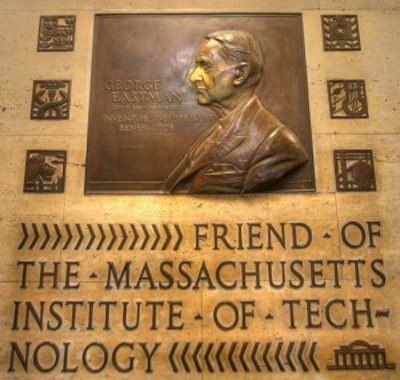 People apparently like to rub statues for good luck.
People apparently like to rub statues for good luck.
At MIT, there’s a relief of George Eastman (think Eastman Kodak) where students about to enter a physics lecture hall used to rub the nose for good luck on exams. (Rumor had it that there was also a relief of Ellen Swallow Richards, where the undergrads would rub her breasts for good luck; one hopes that particular instance has fallen by the wayside nowadays.) I never quite got idea of rubbing statues, but apparently it’s a thing.
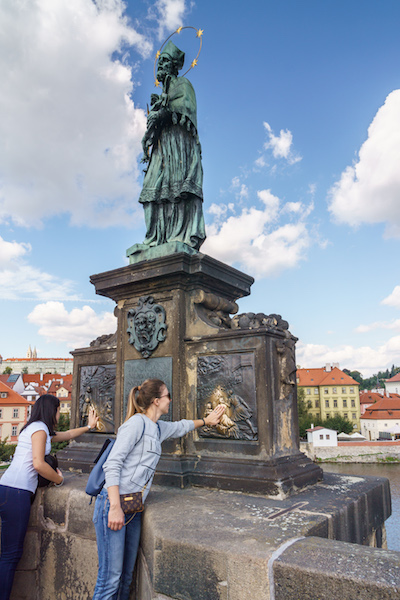 Also apparently, this whole horrific scene has somehow become a tourist attraction. Maybe
that’s good, rehabilitating ugly things in the past? Tour guides lead people to the
bridge, which I admit is quite scenic and has quite a bit of nice artwork. Then they tell
the tourists that touching St Jan or the Queen Sophia either brings good luck, or ensures
one will return to Prague, or… something.
Also apparently, this whole horrific scene has somehow become a tourist attraction. Maybe
that’s good, rehabilitating ugly things in the past? Tour guides lead people to the
bridge, which I admit is quite scenic and has quite a bit of nice artwork. Then they tell
the tourists that touching St Jan or the Queen Sophia either brings good luck, or ensures
one will return to Prague, or… something.
Also, people like dogs, so they pet the dog too, because apparently it’s easier to reach the dog than the saint or the queen. Shown here is a view of 2 tourists doing exactly that, with a view of the whole statue above the plaques. (Did you remember we’ve thus far only been talking about 2 minor plaques at the bottom, not the main statue? Surprise!)
Ok, that’s slightly amusing. People turn a martyrdom into a happy petition for good luck. I can work with that, though I was hoping for a simple story about petting dogs.
But nothing is ever allowed to be simple, it seems.
How long has that been going on?
The statue was erected about 300 years after the martyrdom, so call it 1683 or so. For how much of the intervening 3+ centuries since then until today have people been rubbing the saint, the queen, and the dog here, hoping for good luck and return tickets?
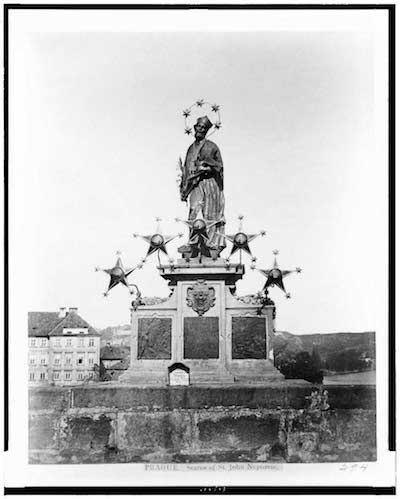
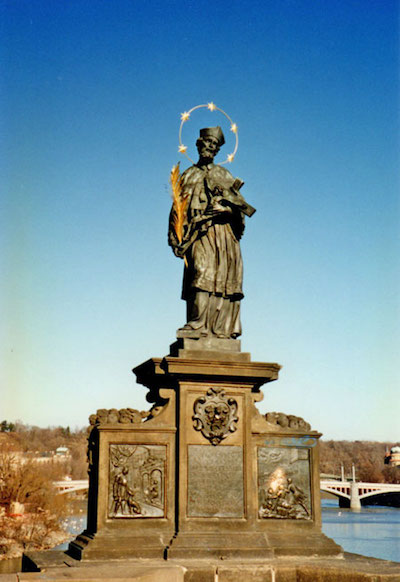
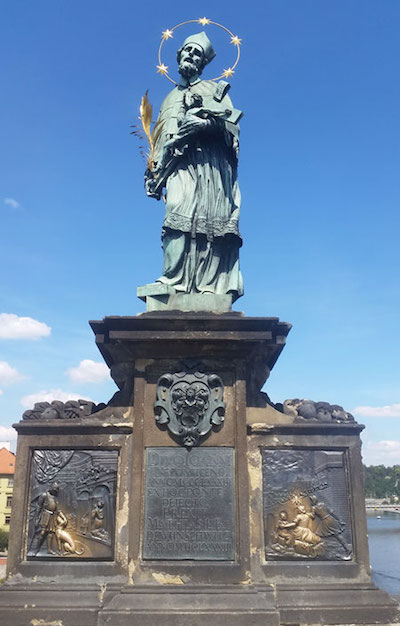 Not, as it happens, for very long.
Not, as it happens, for very long.
The first photo here shows the statue in 1860, complete with the very baroque 5 stars said to have arisen from the river when the saint was killed. Note there are no polished spots from handsy tourists. Just a couple of dull brown reliefs. (Also note the odd mixture of 6-point stars around his head and 5-point stars at his feet. What’s going on there? And it’s too bad the 5-pointers at his feet are only stellated to one level; it would have been cool to try to represent the full fractal here. What? Nerds like symbolism too, you know.)
The middle one was taken in 1996, and shows exactly one shiny spot, on the saint himself. For a very Catholic environment, making an appeal to the saint makes pretty good sense. Nobody was much interested in the queen or the dog, though.
Finally, the bottom picture from 2020 shows 3 burnished spots: saint, queen, and dog. So it looks like the dog-polishing tourists started sometime in the last 25 years. That matches up with the 1989 Velvet Revolution, after which tourism became serious.
In this bottom photo, I can just about make out the Latin inscription:
DIVO IOANNI
NEPOMUCENO
ANNO MCCCLXXXIII
EX HOC PONTE
DEIECTOEREXIT
MATHIAS L.B.
DE WUNSCHWITZ
ANNO MDCLXXXIII
Which, not to make my long-ago Latin tutors spin too fast in their graves, might be rendered (thanks to commenter M 2ler for advice on the dative case and the verb deiicio):
To the Divine Jan
of Nepomuk
in the year 1383 (NB: sources agree should be 1393)
from this bridge
cast downErected by
Mathias L.B.
of Wunschwitz
in the year 1683
That matches what we know: the statue was built in 1683 by one Jan Brokoff, based on a model by Matthias Rauchmiller. (So I don’t know what the “LB” after Mathias means? See below; one commenter thinks the B has something to do with a barony.) Interestingly, this is well before Jan Nepomuk was beatified in 1721 or canonized in 1729.
I’m really tempted to coin the neologism “depontificated” (thrown over the bridge) in parallel to “defenestrated” (thrown out the window). (See comment below from one more competent than me in these matters: the relevant neologism would be “depontation”, from dēpontāre.) But I’m kind of starting to like old Jan Nepomucký, so let’s not make too much fun of the occasion of his death.
The Weekend Conclusion
As I’m fond of telling students: interpretation is an active choice on your part, and one you must make lest circumstances force an unsavory choice upon you.
So what’s our active choice here?
On the one hand, we can be “realists” about this story. Or on the other hand, we can choose to do nothing for interpretation. But if I choose nothing, my pessimistic (and usually depressed) mind will drift toward the dark. No, it’s not about good people wanting to pet dogs. It’s about jealous husbands, secrecy, authoritarian tyrrany, military occupation, state-authorized torture, political murder, and… look, I’m just gonna just stop there, ok?
On the gripping hand: it’s a story about persistence in keeping a promise (the seal of the confessional), about revering loyal people even centuries afterward, and about turning a horrible historical event into a hope for good luck.
And, in spite of all the humans and their crappy behavior, it’s also about a loyal dog who inspires people to pet him or her affectionately. People are complicated, but that dog loves some of them anyway.
It’s hard to live up to the example of a saint, particularly one who’s been martyred. But maybe we can start by at least trying to live up to the example of the dog?
Notes & References
1: LivingPrague Staff, “Prague Jan Nepomuk Statue”, LivingPrague.com, posted in 2020, retrieved 2022-Feb-13. ↩
2: M Muzdakis, “This Relief of a Saint’s Dog Shines Gold From Many Years of Pets for the ‘Good Boy’”, My Modern Met, 2021-Dec-08.
NB: The dog is usually thought to be the soldier’s dog, not the saint’s dog. ↩

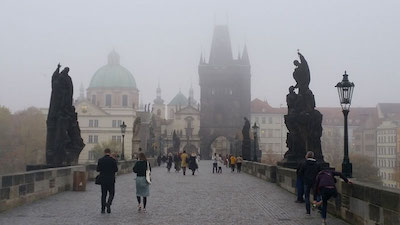
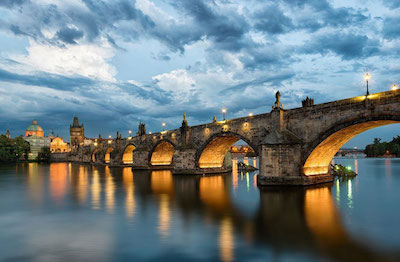
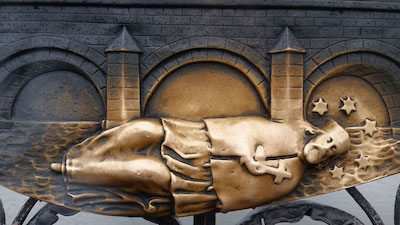
Gestae Commentaria
The statue on the top may date from 1683, but those bronze bas-relief plaques around the base with the lady, and the knight, and the dog and so on, are very much from the modern period. They look distinctly early 20th century. They are rendered in a faux-retro style that was popular in the 1920s-1940s, maybe even a little later.
First things first: welcome to the Weekend Commentariat!
How interesting – I had not thought about whether the plaques might be from a different era. Thank you for pointing out this possibility.
However, the photo above from 1860 shows the plaques in place and appearing somewhat oxidized even then, so they’re at least from the 19th century. On the other hand, the array of stars on the base in the 19th century was removed by the 20th. So your point that people have been monkeying about with this statue is an excellent one.
The custom of rubbing them, of course, seems to be from the 1990s based on the photographs above.
I wonder if there’s some curator in Prague to whom we can write to get the definitive bits?
Oh, one more matter, of more importance than the last…
Given that the bridge is named the Charles Bridge, and that it is famous for depontation (the word hasn’t made it into English yet, but that never stops a real scholar), surely it should be called the Chuck Bridge?
First, you are just about the only person on the entire planet with whom I can share jokes like that. So, thanks (both for the Latin dad joke and for bumping the comment count).
Second, I like your ‘depontation’ from dēpontāre much better than mine. ‘Depontification’ sounds like impeaching the Pope, or something.
The saint’s name is surely dative, as the statue was dedicated to him; deiectus from deiicio, “cast down,” so:
To Saint Jan of Nepomuk, cast down from this bridge in the year 1383
I dunno about the L.B., though I think the “B” is for baron—Renaissance Latin, not my thing.
A much higher resolution image here.
Ah, thank you.
I was a bit bamboozled by deiectus, and too lazy to look it up.
Good thing I have friends who actually know what they’re talking about, no? I’ve updated the translation in the relevant bits.